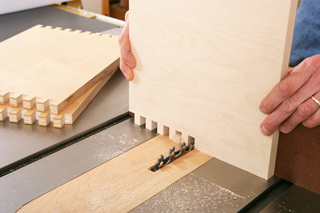
I recently undertook a project for charity which calls for a lightweight box to carry some rather heavy stands for banners. I decided to make it of 1/2″ Baltic birch. I also decided to use box joints for maximum strength. I purchased a router table jig at Rockler to make box joints. The jig worked beautifully on the ends and sides of the box, but the top and bottom are 49″ by 15″, and it was virtually impossible to hold the piece steady in the jig because of the size. Also, I couldn’t do ends of the pieces because of the length. I realized I needed a jig which rode on the edge of the piece. I have somewhat limited experience with jig-making. Any ideas on how to make such a jig for use with a handheld router? – John Leland Mothershead
Chris Marshall: Making box joints with a handheld router is going to require a clamp-on template system and an extremely accurate one, at that. Box joints allow little tolerance for poorly fitting parts, as I’m sure you’ve discovered with your project up to this point. Honestly, I would not suggest making a router jig yourself; I suspect you’ll spend more time trying to get it to work properly than you will finishing your project. Here are two suggestions: First, there are some manufacturers, such as Keller Dovetail Jig and Prazi Chestmate, offering jigs that allow you to cut box joints of any length you need using a handheld router. Keller’s system is bulletproof (I really like it!), but it’s expensive. Still, it will last you a lifetime, and of course it will cut dovetails, too. Chestmate’s system is much more affordable but it will probably have a longer learning curve for you to master. I have used it to build dovetails with good success, but I have not tried making box joints with it yet. My other suggestion would be to switch tools altogether: consider using a dado blade in your table saw and making a simple miter gauge jig with a pin in it. Woodworkers have been milling box joints at the table saw easily and successfully for a very long time, and you can make the jig fence as long or as tall as you need to suit your larger workpieces. Made from scrap, it costs you next to nothing.
Tim Inman: I love to make boxes, but something like a Victorian lap desk is about the max I do. So something akin to a small casket is beyond my normal reach. That said, I’m wondering if a simple crate box joint system might not be just as effective, and a lot simpler to construct. One-half inch birch (I’m assuming Baltic plywood birch here) might not be the best material for box joints anyway in something that large. A simple cleat fastened with glue and screws on the inside of the corners would be infinitely stronger, and much more utilitarian. A compound rabbet would make a little more elegant appearance, if that is important. If it were me, and the box was just a utility box for banner storage, I’d go with the crate box system, and put my better efforts into something better deserving of your fine skills and labors.





